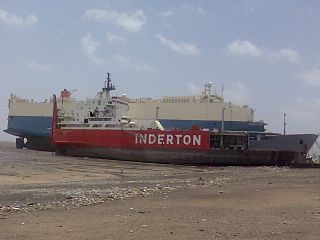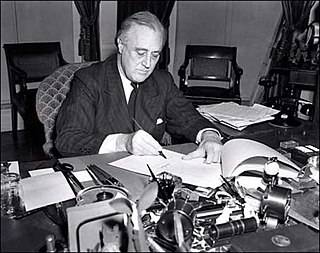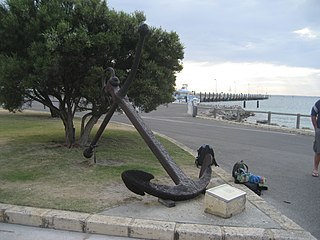
A shipwreck is the remains of a ship that has wrecked, which are found either beached on land or sunken to the bottom of a body of water. Shipwrecking may be deliberate or accidental. In January 1999, Angela Croome estimated that there have been about three million shipwrecks worldwide.

The Swan River Colony was a British colony established in 1829 on the Swan River, in Western Australia.

Gage Roads is an area in the outer harbour area of Fremantle Harbour in the Indian Ocean offshore from Fremantle, Western Australia.

HMAS Adroit was an Attack-class patrol boat of the Royal Australian Navy (RAN).
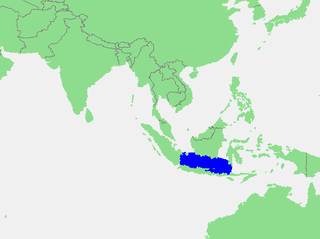
The Java Sea is an extensive shallow sea on the Sunda Shelf. It lies between the Indonesian islands of Borneo to the north, Java to the south, Sumatra to the west, and Sulawesi to the east. Karimata Strait to its northwest links it to the South China Sea.
The Western Australian Museum is the state museum for Western Australia. It has six main sites: in Perth within the Perth Cultural Centre, two in Fremantle, and one each in Albany, Geraldton, and Kalgoorlie-Boulder. The Western Australian Museum is a statutory authority within the Culture and the Arts Portfolio, established under the Museum Act 1969.

The Graveyard of the Pacific is a somewhat loosely defined stretch of the Pacific Northwest coast stretching from around Tillamook Bay on the Oregon Coast northward past the treacherous Columbia Bar and Juan de Fuca Strait, up the rocky western coast of Vancouver Island to Cape Scott. Unpredictable weather conditions, fog and coastal characteristics such as shifting sandbars, tidal rips and rocky reefs and shorelines have claimed more than 2,000 shipwrecks in this area. Although major wrecks have declined since the 1920s, several lives are still lost annually.
Over 1400 ships have been wrecked on the coast of Western Australia. This relatively large number of shipwrecks is due to a number of factors, including:
Tryall was a British East India Company-owned East Indiaman launched in 1621. She was under the command of John Brooke when she was wrecked on the Tryal Rocks off the north-west coast of Western Australia in 1622. Her crew were the first Englishmen to sight or land on Australia. The wreck is Australia's oldest known shipwreck.

Tryal Rocks, sometimes spelled Trial Rocks or Tryall Rocks, formerly known as Ritchie's Reef or Greyhound's Shoal, is a reef of rock located in the Indian Ocean off the northwest coast of Australia, 14 kilometres (8.7 mi) northwest of the outer edge of the Montebello Islands group. It is named for the Tryall, the first known shipwreck in Australian waters, which sunk after striking the then-uncharted rocks in 1622. Described as "the theme and dread of every voyager to the eastern islands", their location was sought for over three centuries before finally being determined in 1969.

City of York was a 1,194 ton iron ship which sank after hitting a reef off Rottnest Island in the last few kilometres of its voyage from San Francisco to Fremantle, Western Australia in 1899.
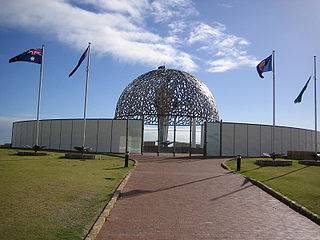
Numerous attempts were made to find the Australian cruiser HMAS Sydney and the German auxiliary cruiser Kormoran, which were both lost in a sea battle in 1941. Efforts immediately after the battle focused on finding Sydney when she failed to return to port. While searchers located over 300 survivors from Kormoran, none of the 645 aboard the Australian warship were found.
The Loch Line of Glasgow, Scotland, was a group of ill-fated colonial clippers managed by Messrs William Aitken and James Lilburn, whose sailing ships plied between the United Kingdom and Australia from 1867 to 1911.
Lady Elizabeth was a British ship built in 1869 by Robert Thompson Jr. of Sunderland. Robert Thompson Jr. was one of the sons of Robert Thompson Sr. who owned and operated the family ran shipyard J. L. Thompson & Sons. Thompson Jr. eventually left the family business in 1854 to start his own shipbuilding business in Southwick, Sunderland. She was 658 tons and was classified as a barque cargo sailing ship with one deck and three masts. She had a keel and outer planking made from American rock elm and a fore end made from English elm. The stem was made of teak and English oak with an iron floor as the deck. The ship also had copper and iron fastings. The ships was also registered in London under the name Wilson & Co. Messrs Wilson & Co. was based out of Sydney, Australia. The ship carried a comparative classification under American Lloyd's as "First class-third grade"

Completed in 1849, the original 20-metre (66 ft) Wadjemup Lighthouse was Western Australia's first stone lighthouse and was built to provide a safer sailing passage for ships to Fremantle Port and the Swan River Colony.

Rottnest Island lies 18 kilometres west of the coastline of Perth, Western Australia, and is 4.5 km (2.8m) at its widest, and 11 km long.

RMS Orizaba was a mail steamer wrecked off Rockingham, Western Australia on 16 February 1905. On her approach to Fremantle, a smog of bushfire smoke was obscuring the coast and the captain lost his bearings. The ship went aground in 6.1 metres (20 ft) of water on Five Fathom Bank, west of Garden Island.
